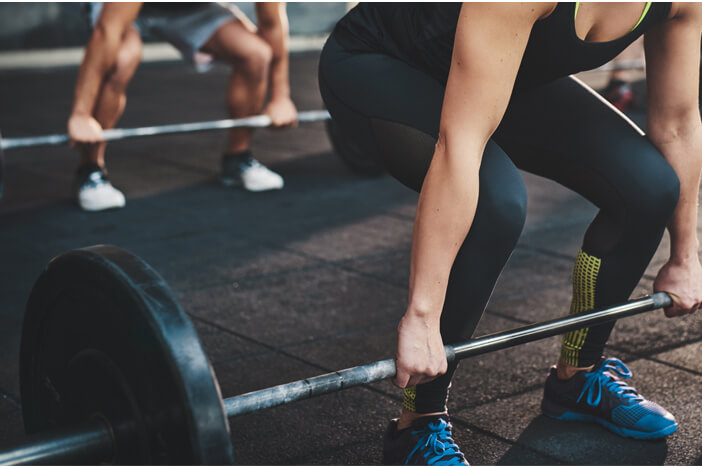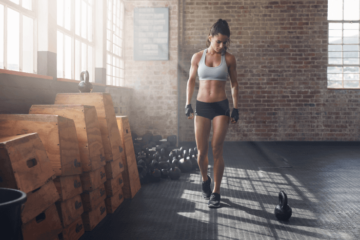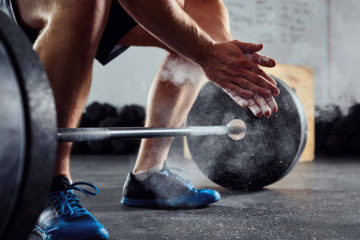Deadlifts - The exercise for a strong back

Deadlifts: Targeted muscle groups
Deadlifts are one of the core exercises of weight training and incorporate almost the entire body. Deadlifting is however also a controversial exercise: one often hears that deadlifting is harmful to the back. However, when performed correctly, the opposite is true, and deadlifts really strengthen the back.
Primarily targeted muscle groups:
- Erector spinae
- Quadriceps
- Gluteus Maximus (large gluteus muscle)
Secondary muscle groups used:
- Long head of the bicep
- Semitendinosus muscle
- Flat tendon muscle
- Trapezius muscle
- Rhomboidus
- Latissimus
Deadlifting is one of the basic weight training exercises. It involves many muscle groups, but primarily the back, thighs and bottom. Take a look at our pages about back, leg and bum training and learn more about how to integrate deadlifts into your training.
Correct execution of deadlifts

Your stance
At the beginning of the exercise stand with your legs waist width apart. Your feet should be completely flat on the floor and your toes pointing slightly outwards (15°-30° angle).
Your grip
Grasp the barbell about shoulder width so that your arms do not touch the outside of your legs. You can grip the barbell either in the upper grip or the cross grip. In both variations, your thumbs enclose the barbell. With the cross grip, a high load can be placed on the biceps. The upper grip is generally recommended for beginners to minimize the risk of injury. Experienced strength athletes tend to use the cross grip because it provides them with more stability when the additional weight is high and prevents the barbell from slipping out of their hands. Some people have a problem with slippery hands, or their grip strength, and are aware of their fingers or forearms when performing deadlifts. Since this sensation can have a negative effect on the exercise performance (the upper back rounds off instead of keeping tension), prior training of grip strength is useful. If you still want to do deadlifting, but you have a weak grip, you can try using grip aids, so-called “lifting straps”. However try not to get used to these aids, it is better to work on building up an adequate grip strength.
Starting position
The barbell should be located on the floor in front of your shins, directly above your metatarsus. Then kneel down and slide your shins over the barbell bar. At the same time bend your upper body forward so that your shoulders are slightly in front of the barbell. Shortly before the upward movement push your chest out and your lower back forward. Your back must be kept straight during the whole exercise – never round it! Your head should be in line with your spine. To help with this fix your gaze on an imaginary point on the floor about 5 meters away. Squeeze your arms before lifting so that they are under tension. The slightest misalignment in your starting position will hinder your performance and carries a high risk of injury.
Breathing
To maximise your performance take a deep breath in during the upward movement. Hold your breath for a short moment and tense your abdominal muscles with all your strength. This increases the intra-abdominal pressure, which makes your chest rigid and keeps your upper body straight. As a result, your organs, spine and intervertebral discs are relieved. The built up tension blocks your upper body and back and keeps it in position so that your upper body can remain straight during the whole exercise.
In summary, first build up tension by taking a deep breath and holding it briefly. In the final position, you should exhale and then inhale again before lowering your weight. You should also hold your breath during the downward movement.
The upward movement
Avoid a swinging or violent jerk action where you bend your arms. Once you have positioned yourself correctly and your breathing is under control, straighten your upper and lower body at the same time, hips and shoulders should change their position in parallel. The rest of your posture (stance, back, head, arms) remains in the same position as at the beginning. Only the angle in your knee joints should change before the barbell bar reaches your knees. The angle between the floor and your upper body should remain the same until the barbell has passed your knees. Then straighten up your upper body, with simultaneous hip extension. When moving the barbell upwards, move the bar as close as possible to your shins (during the parallel movement) and thighs (during the straightening) – it is therefore a vertical movement straight up, with the arms not moving and always remaining stretched. In the final position push your pelvis forward and start to exhale. Do not pull your shoulders upwards, but rather let them hang.
The downward movement
The downwards movement is just like the upwards movement only the other way round. First you push your hips backwards and bend your upper body forward with your back straight while you move the bar down along your thighs. In doing so, your knees are passively and automatically bent slightly, without, however, pushing them forward. Only when the bar reaches the height of your knees, should you start to bend your legs but from this moment on you fix your upper body so that shoulder and hips move parallel to each other. The movement is over when you are back in the starting position with the barbell down. If you do several repetitions, avoid bouncing and cushioning the bar on the floor. Each repetition is started from the floor. For single repetitions with very high weight (only for advanced users!) it is common to drop the bar from the upper position in a controlled way. But please note: for this version a weight lifting platform is required.
Weight recommendation for deadlifts

When doing deadlifts, technique is key. You should start with a low weight and only progress to a higher weight when you have honed the technique. Beginners should begin by using the bar without any added weights until they have learned the sequence of movements involved. Since the starting position of the bar is very low without weight plates on the barbell, you can lift it onto two steppers, stools or the safety bars of a rack instead. Once you have got the technique in place, it is important that you slowly increase the weight. If you always train with too little weight, you will not get a feeling for the right movement. Since deadlifting involves so many muscles in your body, it is one of the free weight exercises where you can lift the most weight.
Equipment required for deadlifts
- Barbell (preferably an Olympia barbell with 220 cm length)
- If necessary weight discs, power rack or other barbell mount
Variations of deadlifts

Sumo deadlifts
For sumo deadlifts you do not stand shoulder-width apart, but as wide as possible. By standing wider, the load is shifted to your hips and relieves your lower back. The movement is basically the same, but the range of motion is much smaller and the back is much more upright from the beginning. In addition, more flexibility is needed in the hip region and the adductors to properly assume the starting position.
Rack-pulls
With rack pulls, you don’t lift the weight from the ground, but from an elevation just below the knee. This variation reduces the range of motion because the first part of the movement is eliminated. Instead, you can train possible weaknesses in the middle part of the movement in a more targeted way and also strengthen your back extension, upper back and grip strength. The leg extenders are much less challenged in this variation.
Typical errors with deadlifting

- A hunchback: your back must remain straight during the entire exercise in order to protect the intervertebral discs and prevent unnecessary injuries. If you are prone to hunching your back when deadlifting, focus on sticking out your chest and pulling your shoulder blades backwards and downwards. If your back only becomes rounded in the lower half of the movement, you should position your buttocks a little lower in the starting position. A rounded back is also often the result of too much weight on the barbell bar. If your technique is not en pointe, you should reduce the weight.
- A hollow back: a hollow back can occur during deadlifting either during the lockout (upper end position), the upward movement or the downward movement. It puts extreme strain on the back, so you should take care to avoid it. The way to do this is to pay attention to your core strength throughout the exercise. Take a look in the mirror to see and feel the difference between a straight back, a hunched back and a hollow back.
- Knees in the way: if you start bending your knees as you are moving down, they will suddenly get in the way when you lower the weight. For this reason, you should only bend your knees when the barbell has reached the height of your knees. Before you do this, you should imagine the movement as a pushing back of your hips.
Frequently asked questions and answers
You should do deadlifting about twice a week. Make sure that you give the affected muscle groups enough time to regenerate between the two training sessions.
When doing deadlifts, technique is key. You should start with a low weight and only progress to a higher weight when you have honed the technique. Beginners should begin by using the bar without any added weights until they have learned the sequence of movements involved. Since the starting position of the bar is very low without weight plates on the barbell, you can lift it onto two steppers, stools or the safety bars of a rack instead. Once you have got the technique in place, it is important that you slowly increase the weight. If you always train with too little weight, you will not get a feeling for the right movement. Since deadlifting involves so many muscles in your body, it is one of the free weight exercises where you can lift the most weight.
Pay particular attention to keeping a straight back, correct breathing technique and a controlled execution. Correct technique is much more important than lifting as much weight as possible, especially because the risk of injury increases dramatically if the exercise is performed incorrectly.



